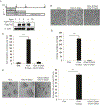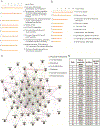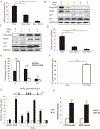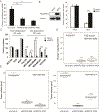Targeting TAZ-Driven Human Breast Cancer by Inhibiting a SKP2-p27 Signaling Axis
- PMID: 30237296
- PMCID: PMC6318031
- DOI: 10.1158/1541-7786.MCR-18-0332
Targeting TAZ-Driven Human Breast Cancer by Inhibiting a SKP2-p27 Signaling Axis
Abstract
Deregulated expression of the transcriptional coactivator with PDZ-binding motif (WWTR1/TAZ) is a common feature of basal-like breast cancer (BLBC). Yet, how oncogenic TAZ regulates cell-cycle progression and proliferation in breast cancer remains poorly understood, and whether TAZ is required for tumor maintenance has not been established. Here, using an integrative oncogenomic approach, TAZ-dependent cellular programs essential for tumor growth and progression were identified. Significantly, TAZ-driven tumor cells required sustained TAZ expression, given that its withdrawal impaired both genesis and maintenance of solid tumors. Moreover, temporal inhibition of TAZ diminished the metastatic burden in established macroscopic pulmonary metastases. Mechanistic investigation revealed that TAZ controls distinct gene profiles that determine cancer cell fate through cell-cycle networks, including a specific, causal role for S-phase kinase-associated protein 2 (SKP2) in mediating the neoplastic state. Together, this study elucidates the molecular events that underpin the role of TAZ in BLBC and link to SKP2, a convergent communication node for multiple cancer signaling pathways, as a key downstream effector molecule. IMPLICATIONS: Understanding the molecular role of TAZ and its link to SKP2, a signaling convergent point and key regulator in BLBC, represents an important step toward the identification of novel therapeutic targets for TAZ-dependent breast cancer.
©2018 American Association for Cancer Research.
Conflict of interest statement
The authors declare no potential conflicts of interest.
Figures






Similar articles
-
S-phase kinase-associated protein 2 knockdown blocks colorectal cancer growth via regulation of both p27 and p16 expression.Cancer Gene Ther. 2013 Dec;20(12):690-4. doi: 10.1038/cgt.2013.70. Epub 2013 Dec 13. Cancer Gene Ther. 2013. PMID: 24336114
-
Isoprenylcysteine carboxylmethyltransferase is required for the impact of mutant KRAS on TAZ protein level and cancer cell self-renewal.Oncogene. 2020 Jul;39(31):5373-5389. doi: 10.1038/s41388-020-1364-7. Epub 2020 Jun 19. Oncogene. 2020. PMID: 32561852 Free PMC article.
-
Simvastatin-induced cell cycle arrest through inhibition of STAT3/SKP2 axis and activation of AMPK to promote p27 and p21 accumulation in hepatocellular carcinoma cells.Cell Death Dis. 2017 Feb 23;8(2):e2626. doi: 10.1038/cddis.2016.472. Cell Death Dis. 2017. PMID: 28230855 Free PMC article.
-
The role of Skp2 and its substrate CDKN1B (p27) in colorectal cancer.J Gastrointestin Liver Dis. 2015 Jun;24(2):225-34. doi: 10.15403/jgld.2014.1121.242.skp2. J Gastrointestin Liver Dis. 2015. PMID: 26114183 Review.
-
Skp2 Inhibitors: Novel Anticancer Strategies.Curr Med Chem. 2016;23(22):2363-79. doi: 10.2174/0929867323666160510122624. Curr Med Chem. 2016. PMID: 27160538 Review.
Cited by
-
TGFβ and Hippo Signaling Pathways Coordinate to Promote Acinar to Ductal Metaplasia in Human Pancreas.Cells. 2024 Jan 18;13(2):186. doi: 10.3390/cells13020186. Cells. 2024. PMID: 38247878 Free PMC article.
-
METTL3 stabilization by PIN1 promotes breast tumorigenesis via enhanced m6A-dependent translation.Oncogene. 2023 Mar;42(13):1010-1023. doi: 10.1038/s41388-023-02617-6. Epub 2023 Feb 8. Oncogene. 2023. PMID: 36755057
-
TAZ maintains telomere length in TNBC cells by mediating Rad51C expression.Breast Cancer Res. 2021 Sep 6;23(1):89. doi: 10.1186/s13058-021-01466-z. Breast Cancer Res. 2021. PMID: 34488828 Free PMC article.
-
Genome-Wide Characterization of TAZ Binding Sites in Mammary Epithelial Cells.Cancers (Basel). 2023 Sep 25;15(19):4713. doi: 10.3390/cancers15194713. Cancers (Basel). 2023. PMID: 37835407 Free PMC article.
-
USP1 Regulates TAZ Protein Stability Through Ubiquitin Modifications in Breast Cancer.Cancers (Basel). 2020 Oct 23;12(11):3090. doi: 10.3390/cancers12113090. Cancers (Basel). 2020. PMID: 33114077 Free PMC article.
References
-
- Beca F, Polyak K. Intratumor Heterogeneity in Breast Cancer. Adv Exp Med Biol. 2016;882:169–89. - PubMed
-
- Paquet ER, Hallett MT. Absolute assignment of breast cancer intrinsic molecular subtype. J Natl Cancer Inst. 2015;107:357. - PubMed
-
- Holm J, Eriksson L, Ploner A et al. Assessment of Breast Cancer Risk Factors Reveals Subtype Heterogeneity. Cancer Res. 2017;77:3708–17. - PubMed
-
- Rakha EA, Reis-Filho JS, Ellis IO. Basal-like breast cancer: a critical review. J Clin Oncol. 2008;26:2568–81. - PubMed
-
- Dey N, Smith BR, Leyland-Jones B. Targeting basal-like breast cancers. Curr Drug Targets. 2012;13:1510–24. - PubMed
Publication types
MeSH terms
Substances
Grants and funding
LinkOut - more resources
Full Text Sources
Other Literature Sources
Medical
Miscellaneous

